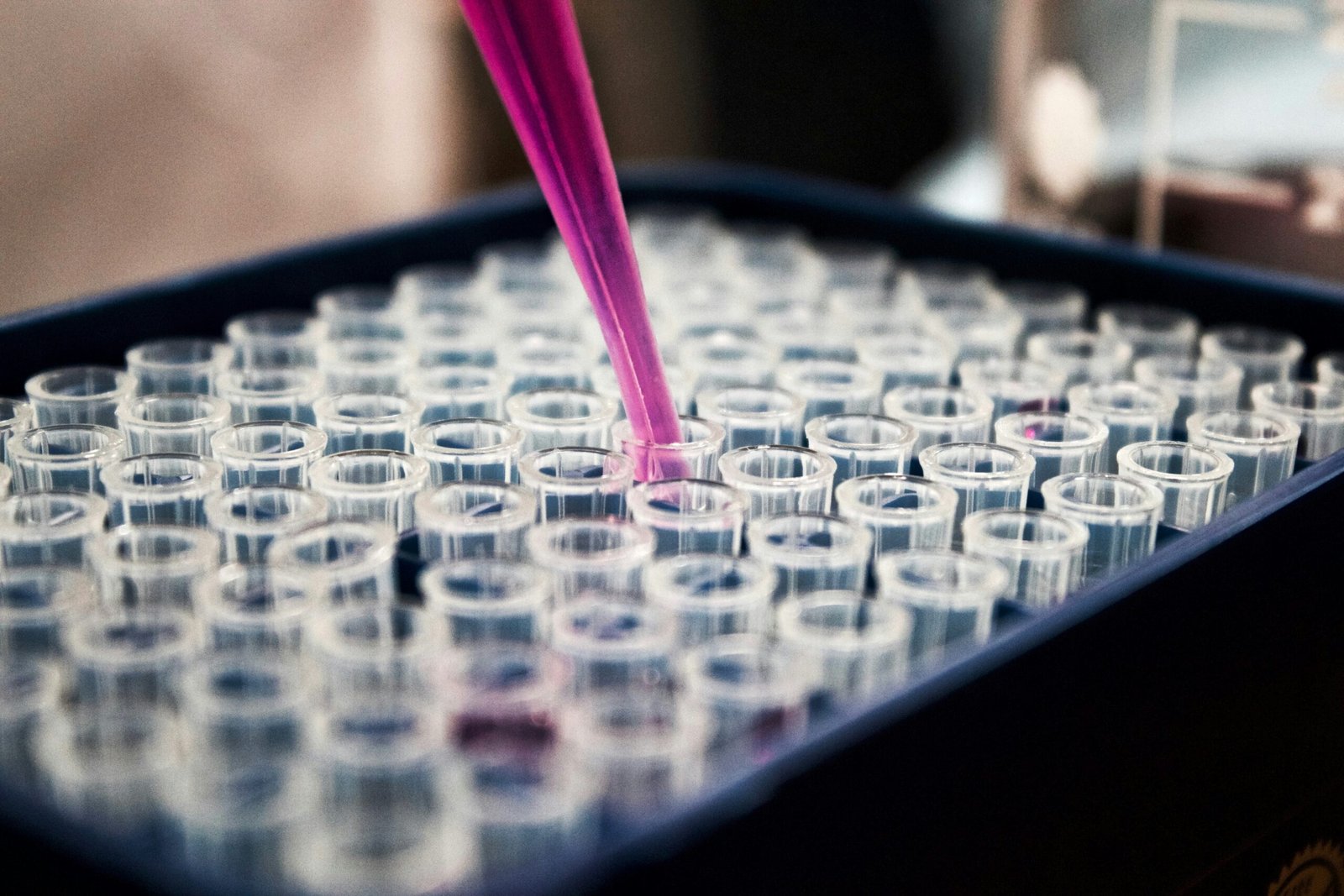Lab-Grown Meat: The Future of Food?
 Photo by Louis Reed on Unsplash
Photo by Louis Reed on Unsplash Introduction to Lab-Grown Meat
Lab-grown meat, also referred to as cultured or cellular meat, represents a significant advancement in the field of food production. This innovative food technology arises from the desire to meet the growing demand for meat while addressing the environmental and ethical challenges associated with conventional animal farming. Essentially, lab-grown meat is produced by cultivating animal cells in a controlled environment, simulating the natural growth process of meat without the necessity of raising and slaughtering livestock.
The process begins with the extraction of a small sample of muscle cells from a live animal, typically a cow or chicken. These cells are then placed in a nutrient-rich culture medium that encourages growth and replication. Utilizing techniques adapted from regenerative medicine, scientists can enable these cells to proliferate and eventually form muscle tissue resembling traditional meat. Over the past decade, advancements in cellular agriculture have allowed for the production of lab-grown meat on a larger scale, making it a feasible alternative to conventional meat.
The origin of lab-grown meat can be traced back to pioneering research conducted in the early 2000s, with the first tangible prototype—a cultured beef patty—being unveiled in 2013. Since then, several companies have emerged in the industry, including Memphis Meats, Mosa Meat, and Eat Just, each striving to innovate and refine the production processes. These key players are driving the development of lab-grown meat as a sustainable food source, potentially transforming the landscape of food production and consumption.
In the subsequent sections, we will explore the various implications of lab-grown meat, focusing on its potential to address food sustainability challenges while considering consumer perceptions and regulatory aspects involved in its introduction into the market.
The Environmental Impact of Traditional Meat Production
Traditional meat production is increasingly scrutinized due to its significant environmental costs, which encompass greenhouse gas emissions, extensive land use, and substantial water consumption. The livestock sector is a major contributor to climate change, with estimates indicating that it is responsible for approximately 14.5% of global greenhouse gas emissions. Methane, released during digestion and manure management, is notably more potent than carbon dioxide in terms of its heat-trapping capability. This presents serious challenges in the fight against climate change, necessitating alternative solutions.
Land use is another critical aspect of meat production that warrants attention. Raising animals for food requires vast amounts of land for grazing and growing feed crops. It is estimated that about 80% of the world’s agricultural land is used for livestock production, which leads to deforestation, habitat loss, and biodiversity declines. The conversion of forests and grasslands into pastures not only contributes to carbon release but also disrupts ecosystems, threatening numerous plant and animal species.
Water consumption is yet another pressing issue linked to conventional meat production. The meat industry uses enormous quantities of freshwater, primarily for animal hydration and feed crop irrigation. Producing just one kilogram of beef requires approximately 15,000 liters of water, highlighting the unsustainable nature of traditional practices. This immense water usage puts additional pressure on already strained freshwater resources, raising concerns about water scarcity in various regions of the world.
In light of these ecological implications, there is a growing need to rethink our relationship with meat and consider more sustainable alternatives, such as lab-grown meat technologies. This would not only help mitigate the environmental impacts associated with conventional meat production but also address pressing issues related to climate change and resource depletion.
How Lab-Grown Meat is Produced
The production of lab-grown meat involves advanced biotechnological techniques that aim to replicate traditional meat without the need for animal slaughter. Central to this process is cell culturing, which begins with the extraction of muscle cells from a live animal, typically using a biopsy. These cells possess the ability to multiply, and in the lab, they are provided with the necessary nutrients and growth factors to support their development.
Once the cells are isolated, they are placed in a sterile environment known as a bioreactor. This equipment enables the maintenance of optimal conditions for cell growth, including temperature, pH levels, and oxygen supply. The bioreactor also facilitates the scaling up of cell production, allowing for a larger quantity of muscle fibers to be cultivated simultaneously. Through this controlled environment, the cells are stimulated to proliferate and differentiate into muscle tissue, mimicking the texture of conventional meat.
Innovations in lab-grown meat production continue to emerge, with various companies exploring different approaches to optimize efficiency and reduce costs. Techniques such as 3D bioprinting are being investigated, where cells can be arranged in specific patterns to create a more complex structure that resembles traditional meat cuts. Furthermore, the use of stem cells in the initial phases shows promise for enabling faster growth rates and potentially enhancing the nutritional profile of the final product.
Overall, the synthesis of lab-grown meat involves sophisticated processes rooted in cellular biology and biotechnology. As research progresses, the aim is to make lab-grown meat a viable alternative to conventional meat, both in terms of consumer acceptance and environmental sustainability, thus potentially revolutionizing the future of food.
Health and Nutritional Aspects of Lab-Grown Meat
Lab-grown meat, also known as cultured or cell-based meat, presents several health benefits and concerns that merit investigation. One primary advantage is that lab-grown meat can be engineered to have specific nutritional profiles tailored to consumer needs. This technology allows for an enhancement of essential nutrients, such as omega-3 fatty acids and vitamins, while reducing unhealthy components, like saturated fats. Additionally, lab-grown meat holds the potential for a reduction in antibiotic use, a pressing issue with conventional livestock farming. By cultivating meat in a controlled environment, the need for antibiotics to prevent disease outbreaks in crowded conditions may be significantly minimized, thus fostering better public health.
However, in addressing food safety, it is essential to understand the measures implemented in the production of lab-grown meat. The controlled environment in which it is produced reduces exposure to harmful pathogens and contaminants typically found in traditional meat processing. Nevertheless, regulatory frameworks and safety standards will play a critical role in ensuring that these products are safe for consumption, as they are still subject to scrutiny by authorities such as the Food and Drug Administration (FDA).
Consumer perceptions regarding the health implications of lab-grown meat are evolving. Many individuals view it as a healthier alternative, largely due to its potential to be free of antibiotics and hormones used in conventional meat production. However, there remain concerns about the innovations associated with lab-grown meat. Terms like “synthetic” can induce skepticism among consumers, affecting their willingness to embrace this new food source. Overall, lab-grown meat presents significant opportunities for optimizing nutritional value while addressing emerging health concerns and reshaping consumer attitudes towards food safety.
Economic and Social Implications
The emergence of lab-grown meat represents a significant shift in the agricultural and food production landscape, raising important economic and social considerations. One crucial aspect is the cost of production; currently, lab-grown meat is considerably more expensive than conventional meat. However, advancements in technology and increased investment in research and development are expected to reduce production costs over time. As these costs decrease, lab-grown meat is likely to become a more viable market option, potentially revolutionizing how meat is produced and consumed.
The market viability of lab-grown meat extends beyond production costs. Market acceptance by consumers will determine its success. Current attitudes towards lab-grown products are mixed, with some segments of the population displaying enthusiasm for sustainable and ethical food sources, while others remain skeptical, often due to a lack of understanding about its benefits. Education and awareness campaigns could play a vital role in shaping societal perceptions and facilitating a broader acceptance of lab-grown meat as a legitimate alternative to traditional meat sources.
The shift towards lab-grown meat also raises concerns about job displacement in traditional agriculture. As this new sector develops, jobs in conventional livestock farming may decline, particularly in regions heavily reliant on meat production. This transition may necessitate workforce retraining and reskilling initiatives to help affected individuals adapt to the changing employment landscape. Conversely, the lab-grown meat industry could generate new employment opportunities in research, production, and distribution, potentially balancing the job market effects.
Ultimately, the adoption of lab-grown meat presents an intricate interplay of economic benefits and societal challenges. As the production methods evolve and societal attitudes shift, lab-grown meat may play an increasingly crucial role in the future of food and sustainable meat consumption culture.
Regulatory Challenges and Food Safety
The emergence of lab-grown meat, also known as cultured or cell-based meat, presents a series of regulatory challenges that are pivotal to its acceptance and success in the food market. As this innovative food technology develops, it requires a comprehensive regulatory framework that can ensure safety and efficacy without undermining consumer confidence. Different countries have approached the regulation of lab-grown meat with varying degrees of preparedness, and the lack of uniform standards can complicate its market rollout.
In the United States, the regulatory landscape combines the efforts of the U.S. Department of Agriculture (USDA) and the Food and Drug Administration (FDA). The key focus of these agencies revolves around food safety standards that must be met before lab-grown meat can be sold to consumers. This encompasses rigorous testing protocols to ascertain that these products are not only safe for consumption but also comparable in nutrition to traditional meat. The FDA’s role is primarily concerned with the early stages of the production process, while the USDA oversees the labeling and production processes, thereby ensuring a cohesive regulatory approach.
Similarly, in the European Union, the regulatory challenges include an extensive evaluation process that assesses the environmental impacts, ethical considerations, and food safety of cultured meat products. The EU’s precautionary stance often leads to a prolonged approval timeline, offering a cautionary tale for how innovations in food technology can encounter bureaucratic hurdles. Other countries, such as Singapore, have begun to take the lead in establishing quicker pathways to market, emphasizing the need for adaptive legislation that supports technological advancements in food production.
Therefore, addressing regulatory challenges is critical in advancing the commercialization of lab-grown meat. As the industry evolves, it is essential for governments to create legislative frameworks that not only prioritize food safety but also stimulate innovation, ensuring the future of this alternative protein source is both secure and accessible.
Public Perception and Acceptance
The public perception of lab-grown meat plays a crucial role in its potential adoption and success in the market. Consumer acceptance is influenced by a myriad of factors, including ethical considerations, environmental impacts, and the level of education surrounding this innovative food technology. Many consumers express concern regarding the morality of producing meat in a laboratory setting, leading to a need for comprehensive education to clarify the benefits and processes involved. Understanding the ethics behind lab-grown meat could sway opinions and foster acceptance among those hesitant about its origins.
Furthermore, environmental consciousness is becoming an increasingly significant driver in consumer choices. As awareness grows regarding the detrimental effects of traditional meat production—such as greenhouse gas emissions, land usage, and water consumption—many are turning towards alternatives that promise a smaller ecological footprint. Lab-grown meat is often hailed as a sustainable solution, as it can potentially reduce resource expenditure and lessen environmental degradation. This aspect of lab-grown food resonates well with eco-conscious consumers, enhancing its acceptability within environmentally aware demographics.
Education also plays a vital role in shaping public perception of lab-grown meat. Providing clear, factual information about the health benefits, safety regulations, and nutritional value of lab-grown meat can alleviate fears associated with “unnatural” food production. Initiatives aimed at educating the public about lab-grown alternatives, including cooking demonstrations and informational campaigns, can significantly improve consumer attitudes. Engaging dialogue among stakeholders—from scientists and industry experts to chefs and food bloggers—can further demystify the concept of lab-grown meat, ultimately promoting broader societal acceptance and encouraging responsible consumption.
Future Prospects and Innovations
The future of lab-grown meat appears promising, driven by rapid technological advancements and an increasing consumer demand for sustainable food sources. As the global population continues to rise, the need for more efficient protein production becomes paramount. Innovations in cellular agriculture, such as tissue engineering and bioreactor technology, are enabling researchers and companies to produce lab-grown meat with greater efficiency and reduced costs. For instance, recent developments in automated systems for monitoring growth conditions have the potential to enhance the scalability of production.
Pioneering companies are at the forefront of this revolution, including names like Memphis Meats, Mosa Meat, and Eat Just. These organizations are heavily investing in research and development to refine their processes and bring lab-grown meat to market. Investors are taking notice, with substantial funding pouring into the sector. This influx of capital facilitates not only technological improvements but also helps in navigating regulatory landscapes, which remain a crucial component for commercializing lab-grown meat.
Market predictions suggest significant growth in consumer acceptance of lab-grown products. Research indicates that an increasing number of people are open to consuming lab-grown meat, driven by concerns over animal welfare, environmental sustainability, and health benefits. However, challenges persist. Regulatory hurdles, ethical debates, and public perceptions can impact market penetration. Overcoming these obstacles will require transparent communication and education about the benefits of lab-grown meat, alongside robust oversight from regulatory bodies to ensure safety and quality.
In conclusion, the future of lab-grown meat sits on the cusp of revolution, promising to reshape the food industry. Continued innovation and collaboration among companies, scientists, and regulatory agencies will be essential for realizing its full potential in mainstream markets.
Conclusion: Lab-Grown Meat’s Role in Food Sustainability
As we have explored throughout this discussion, lab-grown meat represents a significant innovation in the field of food production, with the potential to address some of the pressing challenges surrounding global food security and environmental sustainability. Traditional livestock farming is associated with various issues, including greenhouse gas emissions, land use, and water consumption. In contrast, lab-grown meat offers a more sustainable alternative by significantly reducing the environmental footprint associated with conventional meat production.
The efficiency of lab-grown meat production can lead to a decrease in resource utilization, alleviating pressure on natural ecosystems and contributing to the conservation of biodiversity. Furthermore, lab-grown meat has the potential to enhance food accessibility, particularly in regions where conventional meat production is limited by various factors such as arable land constraints and economic challenges. By producing meat more sustainably, we can ensure that protein-rich food sources are available to a wider population, thereby addressing hunger and nutritional needs.
Innovation in food systems is crucial for developing solutions that cater to a growing global population expected to reach nearly 10 billion by 2050. Lab-grown meat, alongside other emerging technologies such as plant-based alternatives and precision agriculture, can play an integral role in reshaping our food landscape. However, it is essential that the discourse surrounding lab-grown meat remains balanced, taking into consideration ethical, cultural, and regulatory factors. Engaging stakeholders, including consumers, farmers, and policymakers, will be key to navigating the transition towards more sustainable food systems.
In conclusion, lab-grown meat holds promise as a viable solution for enhancing food sustainability and security. As we continue to innovate and adapt our food systems, it is imperative that we foster a comprehensive dialogue on the future of food, ensuring these developments benefit both people and the planet.














Tidak ada komentar